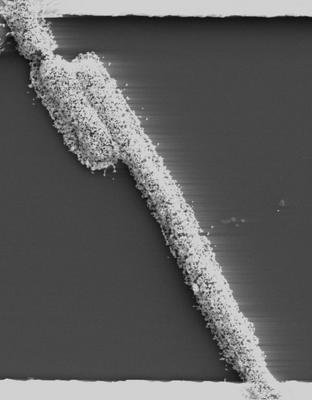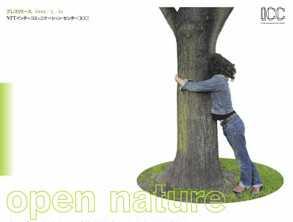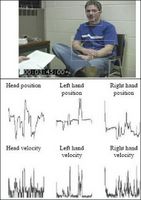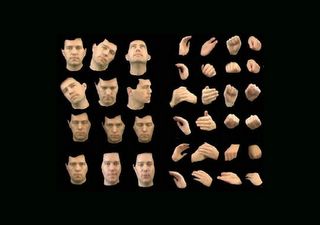Live bacteria used as electrical sensor
Blurring the line between alive and not-alive...Live, gold-dusted bacteria used in bioelectronic device
Office of University Communications
University of Nebraska-Lincoln
Working with Vikas Berry, a doctoral student in his laboratory, Ravi Ravi Saraf created what he said he thinks is the first use of a microorganism to make a bioelectronic device with a live microorganism.
Saraf and Berry deposited bacteria (Bacillus cereus) on a standard silicon chip inlaid with gold electrodes. After the bacteria formed bridges between the electrodes, Saraf and Berry deposited gold nanoparticles measuring about 30 nanometers (30 billionths of a meter) on the bacteria and introduced an electric current.
"On the bacteria's surface, there are these filaments that grab the nanoparticles," said Saraf, who came to UNL last year from Virginia Tech. "When the humidity increases, the bacteria swells because it absorbs moisture, and it contracts when the humidity goes down. When it swells or contracts, it increases or decreases the distance between the nanoparticles."

"That's great, but what really excites me is 'What's next?'" he said. "This work clearly shows that you can make nanodevices on live cells. Now, can we take the next step and have the live cell drive the nanodevice?"
Saraf said his idea is that microorganisms could be used to open and close electronic circuits, and maybe even power them.
University of Nebraska press release...
Quantum Dots Have Bright Future
Chemists at Vanderbilt University discovered a way to make quantum dots spontaneously produce broad-spectrum white light. The report of their discovery, which happened by accident, appears in the communication “White-light Emission from Magic-Sized Cadmium Selenide Nanocrystals” published online October 18 by the
Journal of the American Chemical Society
One difference between the Vanderbilt approach and the others is the process they used to make the quantum dots, Bowers observes. The other groups use synthesis methods that take between a week and a month to complete; whereas, the Vanderbilt method takes less than an hour.

The light bulb is made out of metal and glass using primarily mechanical processes. Current LEDs are made using semiconductor manufacturing techniques developed in the last 50 years. But, if the quantum dot approach pans out, it could transform lighting production into a primarily chemical process. Such a fundamental change could open up a wide range of new possibilities, such as making almost any object into a light source by coating it with luminescent paint capable of producing light in a rainbow of different shades, including white.
Vanderbilt News Service:
Toyota Engineers Air-Scrubbing Shrubbery
Toyota Engineers...a Shrub
Toyota Motor Corp has developed a derivative of the Cherry Sage shrub that is optimized for absorbing pollutants from the air.
The new Kirsch Pink plant is reportedly 1.3 times more effective at absorbing NOx, SO2 and other air pollutants than its parent stock, the Cherry Sage. Toyota is targeting first-year sales of Kirsch Pink at 10,000 plants, priced at ¥380 (US$3.34) each.

The new plant, which flowers between May and November, also diminishes the urban heat-island effect 1.3 times more effectively than the Cherry Sage, according to the company.
The Kirsch Pink is the work of
Toyota Roof Garden, established in 2001 as one of the businesses in Toyota’s Biotechnology and Afforestation portfolio.
Toyota sees a linkage between the automotive industry and the biotechnology industries in that both are aiming to achieve a sustainable society.
Toyota focused on aspects of agricultural biotech for three reasons:
1.An increase in world population, mainly in Asia.
2.An increase in the amount of food consumption per person due to a rise in the income level.
3.A decrease in farm and forest areas due to industrialization and urbanization, and food and water shortages due to an increase in water consumption and worsening of the global environment.
Green Car Congress: Toyota Engineers...a ShrubJapan Times Online
Living Memorial Tree
Biopresence. Human DNA Trees.
Biopresence is an art venture formed by Shiho Fukuhara and Georg Tremmel with the purpose of exploring, participating and ultimately defining the most relevant playing field of the 21st century: the impact of biotechnologies on society and the human perception of these coming changes.
Biopresence creates Human DNA trees by transcoding the essence of a human being within the DNA of a tree in order to create "Living Memorials" or "Transgenic Tombstones".
The Manifold method is based on the naturally occurring silent mutations of base triplets, this means it is possible to store information without affecting the genes of the resulting tree. Biopresence Human DNA Trees do not modify the genes of an organism. Therefore, they are not genetically modified organisms (GMOs).
Through tissue culture, this 'physical essence of human body' is produced, which will decay and release its decomposition products in order to nurture the soil, acting as a source-de-vie for the young plants.

Gone for a few days
I will be out of town for a few days.
Watch for updates from RoboNexus in San Jose at
Robot Gossip.
Go, Space Racer, Go!
‘Rocket racing league’ gets its start
By Alan Boyle
Science editor
MSNBC
The man behind the
$10 million X Prize for private spaceflight is joining forces with a venture capitalist who's also an Indy car backer to establish a NASCAR-like racing league for rocket-powered aircraft.
X Prize founder Peter Diamandis and race car capitalist Granger Whitelaw took the wraps off the
Rocket Racing League during a Monday news conference, just days before a rocket plane demonstration that could serve as a model for the races.
The first rocket racers would be built by
XCOR, with a second generation based on an airframe provided by
Velocity Aircraft of Sebastian, Fla., the league said in a statement. Individual teams would own the racers and be able to customize them.

Diamandis said the souped-up racers would burn kerosene fuel rather than alcohol. "These vehicles will literally sport a 20-foot bright brilliant flame out the back," he said.
Patricia Grace Smith, the FAA's associate administrator for commercial space transportation, indicated at the news conference that the league would get a sympathetic hearing.
"We're here because we see this as another means of making rocket flight more tangible to the public. This is an opportunity to introduce the power and thrill of rockets in the form of high-velocity entertainment," Smith said. "Today's announcement resurrects the great American tradition of air racing, wraps it in the technology of the 21st century, and gives the nation a thrilling glimpse of things to come, thanks to Peter Diamandis and Granger Whitelaw. The Rocket Racing League is an atmospheric showcase for the kind of rocket technology that will evolve in time from spectator sport to citizen suborbital spaceflight."
‘Rocket racing league’ gets its start - The New Space Race - MSNBC.com
Computer Detects Liars
Computer Detects Deception
By Tracy Staedter, Discovery News
New technology could lead to computers that can discern lying and deceptive behavior in people.
The technology, being developed by scientists at
Rutgers, the State University of New Jersey, the
University of Arizona and the
State University of New York at Stony Brook, aims to supplement routine interrogation sessions conducted by law enforcement personnel.

It may also be used to quickly and automatically screen people in high-security spaces, such as airports.
Instead of relying on body physiology, Metaxas' system will use a camera and a special computer program that team members developed to track movements around the eyes, lips, shoulders and hands that even the most experienced eye might miss.
In theory, liars tend to be too agitated or remain too still, no matter what part of the world they are from. That's because every person has their own idea about how a lying person behaves. For example, you might think that a liar doesn't give much eye contact and so when you lie, you might give too much eye contact.
"People have certain associations with what liars do and then they hide those things deliberately," said Joseph Walther, professor of communication at
Cornell University.

Currently, the researchers are using their program to analyze and quantify gestures in real-time videos of people who are being interrogated or who are exhibiting deceptive behavior.
The software measures the velocity and acceleration of movements occurring at different locations on the body and also tracks how frequently these actions take place.
I can't wait until they make this software available through camera phones. It would completely change how sales-people work.Discovery Channel :: News :: Computer Detects Deception










